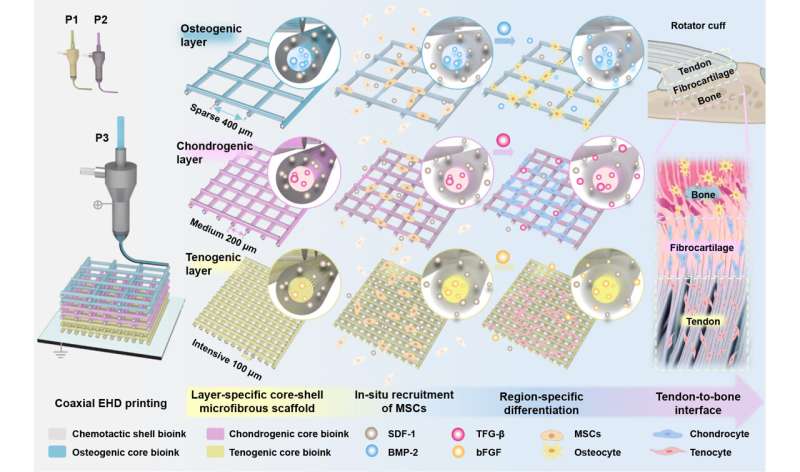This article has been reviewed according to Science X's editorial process and policies. Editors have highlighted the following attributes while ensuring the content's credibility:
fact-checked
proofread
Advanced printing crafts precision scaffolds for tissue regeneration

Researchers at the First Affiliated Hospital of Xi'an Jiaotong University have developed a core-shell microfibrous scaffold that excels in rotator cuff repair.
Published in the International Journal of Extreme Manufacturing, these scaffolds show exceptional repair capabilities, with tissue histology revealing complete restoration to natural morphology and mechanical properties nearly identical to uninjured tissue.
This acellular, in situ tissue engineering technology harnesses stem cell regenerative abilities, providing robust biological regeneration without the need for cell seeding. This advancement significantly reduces post-repair re-tears and enhances surgical outcomes, revolutionizing treatment options in orthopedic surgeries.
Professor Zhanhai Yin, alongside Professor Jiankang He and their team, identified the limitations of current rotator cuff repair methods. "Current techniques often result in re-tears and incomplete healing," explained Professor Yin. "We needed a solution that addresses these issues more effectively."
The team hypothesized that a scaffold mimicking the gradient structure of the tendon-bone interface, loaded with specific growth factors and using a core-shell structure for in situ tissue engineering to recruit stem cells, could significantly enhance tissue repair and reduce re-tears.
"Our idea was to create a scaffold that not only supports tissue growth but also sequentially releases growth factors sequentially to guide the healing process," said Professor He. "This approach achieves sequential chemotaxis and differentiation functions, crucial for effective repair, and leverages the body's own regenerative capabilities for a natural and lasting solution."
Traditional methods for treating rotator cuff tears, such as simple suturing, fail to reconstruct the gradient structure of the tendon-bone interface, leading to stress concentration and increased re-tears. The team aimed to address this by creating scaffolds that guide tissue regeneration more effectively and recruit endogenous stem cells crucial for repair.
Utilizing coaxial electrohydrodynamic printing technology, the researchers developed core-shell microfibrous scaffolds with layer-specific growth factors. They characterized the scaffolds' microstructure and mechanical properties, validated their ability to recruit BMSCs and induce cell differentiation in vitro, and implanted them into rabbit rotator cuff injury sites to assess repair effectiveness through histological staining and biomechanical testing.
"The successful validation of these scaffolds in animal models marks a significant breakthrough in rotator cuff repair," said Professor Yin.
"Our innovative approach, which mimics the natural tendon-bone interface and leverages the body's own regenerative capabilities, has shown exceptional promise. This technology has the potential to significantly improve surgical outcomes and reduce the incidence of re-tears."
Looking ahead, the team plans to refine the printing parameters to ensure seamless gradient transitions within the scaffolds.
"Our next step is to test these scaffolds in large animal models to gather crucial data for future clinical applications," explained Professor He. "This phase is essential for fine-tuning the technology and ensuring its efficacy and safety for human use. We are committed to translating this research into a clinically viable solution that can transform orthopedic surgery."
This innovation represents a profound advancement in medical science, with the potential to set new standards in rotator cuff repair. By enhancing tissue repair and reducing re-tears, this technology could revolutionize the field, providing patients with more reliable and lasting results.
Professor Yin and Professor He are optimistic about its clinical potential, anticipating a transformative impact on orthopedic surgery that could offer new hope and improved quality of life for countless patients.
More information: Lang Bai et al, Coaxial electrohydrodynamic printing of core–shell microfibrous scaffolds with layer-specific growth factors release for enthesis regeneration, International Journal of Extreme Manufacturing (2024). DOI: 10.1088/2631-7990/ad5806




















